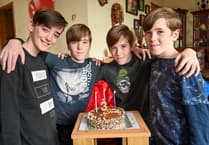IN her latest fascinating article exploring the world of the unknown, the Chronicle’s paranormal expert Claire Barrand looks at the current craze for scary clowns which is sweeping the UK
It cannot have failed to escape even the keenest news dodgers, that there is a current fad sweeping the nation in the form of creepy clowns and whilst I am certainly not wishing to draw further attention to the hype or encourage it in anyway, as a paranormal writer I will note my few thoughts on the matter.
Whilst clowns are not “paranormal” as such, it certainly isn’t “normal” for humans to go around dressed in fake blood and sporting a red nose in order to cause mass hysteria either. My research found that the "clown" character develops out of the zanni "rustic fool" characters of the early modern Commedia dell’arte, which were themselves directly based on the "rustic fool" characters of ancient Greek and Roman theatre.
Rustic buffoon characters in Classical Greek theatre were known as sklêro-paiktês (from paizein "to play (like a child)") or deikeliktas, besides other generic terms for "rustic" or "peasant".
In Roman theatre, a term for clown was fossor, literally "digger; labourer” ... how ironic that the clowns we have read about in the news most undoubtedly are work-shy and very unlikely to be labourers!
The English word clown was first recorded c. 1560 (as clowne, cloyne), the broad meaning "rustic, boor, peasant". The origin of the word is uncertain, perhaps from a Scandinavian word cognate with clumsy. It is in this sense that "Clown" is used as the name of fool characters in Shakespeare’s Othello and The Winter’s Tale. The sense of clown as referring to a professional or habitual fool or jester develops soon after 1600, based on Elizabethan "rustic fool" characters such as Shakespeare’s.
The modern archetype of the evil clown has unclear origins; the stock character appeared infrequently during the 19th century, in such works as Edgar Allan Poe’s "Hop-Frog", which is believed by Jack Morgan, of the University of Missouri-Rolla, to draw upon an earlier incident "at a masquerade ball", in the 14th century, during which "the king and his frivolous party, costumed—in highly flammable materials—as simian creatures, were ignited by a flambeau and incinerated, the King narrowly escaping in the actual case."
Evil clowns also occupied a small niche in drama, appearing in the 1874 work La femme de Tabarin by Catulle Mendès and in Ruggero Leoncavallo’s Pagliacci (accused of being a plagiarism of Mendès’ piece), both works featuring murderous clowns as central characters.
The modern stock character of the evil clown was popularized by Stephen King’s novel It, published in 1986, which became the first to introduce the fear of an evil clown to a modern audience.
Another one of the first appearances of the concept is that of John Wayne Gacy, an American serial killer and rapist arrested in 1978, who became known as the Killer Clown after it was discovered he had performed as Pogo the Clown at children’s parties and other events; however, Gacy did not actually commit his crimes while wearing his clown costume.
The evil clown archetype plays strongly off the sense of aversion, causing inherent elements of coulrophobia; however, it has been suggested by Joseph Durwin, that the concept of evil clowns has an independent position in popular culture, arguing that "the concept of evil clowns and the widespread hostility it induces is a cultural phenomenon which surpasses just the phobia alone".
A study by the University of Sheffield concluded "that clowns are universally disliked by children. Some found them quite frightening and unknowable."
This may be because of the nature of clowns’ makeup hiding their faces, making them potential threats in disguise; as a psychology professor at California State University, Northridge stated, young children are "very reactive to a familiar body type with an unfamiliar face”. This natural dislike of clowns makes them effective in a literary or fictional context, as the hostile menace perceived in clowns is necessary in a wicked character.
Researcher Ben Radford, who published Bad Clowns in 2016 and is regarded as an expert on the phenomenon, writes that looking throughout history clowns are seen as trickers, fools, and more; however, they always are in control, speak their minds, and can get away with doing so. Interesting concept, when you look at the most likely profiles of those perpetrators today, who are likely to be lacking in those qualities in their everyday lives.
When writing the book Bad Clowns, Radford found that professional clowns are not generally fond of the bad-clown (or evil-clown) persona. They see them as "the rotten apple in the barrel, whose ugly sight and smell casts suspicion on the rest of them," and do not wish to encourage or propagate coulrophobia. Yet, as Radford discovered, bad clowns have existed throughout history: Harlequin, the King’s fool, and Mr. Punch.
Radford argues that bad clowns have the "ability to change with the times" and that modern bad clowns have evolved into Internet trolls. They may not wear clown costume but, nevertheless, engage with people for their own amusement, abuse, tease and speak what they think of as the "truth" much like the court jester and "dip clowns" do using "human foibles" against their victims. Radford states that, although bad clowns permeate the media in movies, TV, music, comics, and more, the "good clowns" outnumber the bad ones. Research shows that most people do not fear clowns but actually love them and that bad clowns are "the exception, not the rule."
I find the links between the historic evil clowns fascinating, I wonder do the copycat hoaxers, eagerly awaiting their Snazaroo kits to arrive from Amazon, realise that they have in actual fact set their bar low, by posing as the foolish buffoons of modern society?
The vast majority of those attracted to this spiral of decline will have no actual weapon or intention to do anything other than scare people for the amusement of their equally dimwitted mates, no doubt lurking with a video camera not far away – and these are all generally under achieving or unemployed young men desperate to experience the rush that creating fear in others will give them (albeit temporarily) despite risking serious consequences for themselves and the community should their “prank” turn sinister.
As soon as the weather turns cold and wet I should think we in the U.K will see less of them as they retire back to the comfort of their computer screens where they can take up being keyboard warriors once more!




